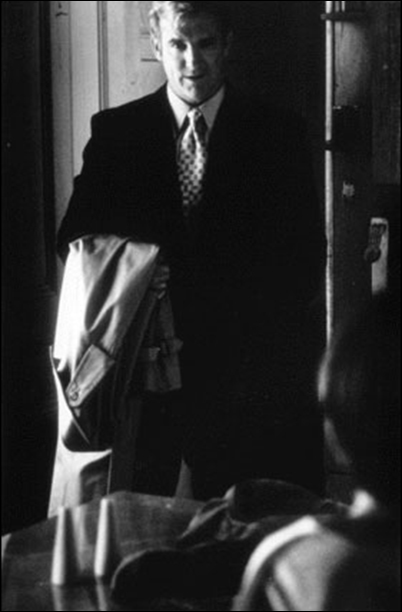Luminous Motion: A Tale of Movement, Gravity and Parricide
Luminous Motion was born of Elyse Goldberg’s and Bette Gordon’s desire to collaborate on a film which examines childhood. They learned of Scott Bradfield’s book The History of Luminous Motion which Goldberg read and enthusiastically recommended to Gordon. Elyse Goldberg convinced the author to meet them in New York and the film project was under way.
****
Through a child’s eyes, Luminous Motion recounts the story of Phillip (Eric Lloyd), a ten-year-old boy who accompanies his mother (Deborah Kara Unger) as she drifts around the country in a Chevrolet Impala. After separating from Phillip’s father, mother takes her son on the road where sexual encounters with strange men and subsequent robberies enable her to buy gas for the Impala and science textbooks for Phillip. When mother and child are alone together in the car, Phillip postulates his theories on space and movement from the back seat, surrounded by planet-like mobiles that hang from the ceiling and reflect neon, moonlight, and headlights from the highway. For Phillip the Impala is like a kinetic womb, that protects and reinforces his filial bond to the mother.

Their travels together come to an end when Phillip wrecks the Impala, and both mother and son are taken in by a friendly if slightly off-kilter carpenter named Pedro. The story turns Oedipal, as Phillip cannot bear the thought of sharing his mother with a paternal figure or living in the suburban quietude (stasis) that Pedro offers. Gordon makes use of overlapped images, out of phase, to represent Phillip’s visions of his mother leaving Pedro’s bed to comfort him and to depict visitations from Phillips biological father who seems to be pursuing them. One evening at home, Pedro extols the virtues of workaday resignation to Phillip while watching a baseball game on television. The relationship between fantasy and reality becomes intentionally obscured but it would appear that Phillip sedates Pedro with a bowl of barbiturate-spiked chili and finishes him off with a cordless drill in the ear (much as the King Father in Hamlet was murdered with poison in the ear, which is meaningful inasmuch as Pedro will soon return as a ghost).

When mother discovers what has transpired, she takes Phillip on the road once again, and they drive on to Newark, New Jersey, where she rents a home and parks the Impala for good. Mother retires to an upstairs room and succumbs to deep depression. She drinks heavily and begins to sleep for long hours while Phillip assumes the role of bread winner and takes a job as a paperboy. One evening Phillip is visited by the bloody, out of phase ghost of Pedro who asserts that there are different kinds of movement and that the moon is in constant motion despite our limited ability to perceive it. Shortly thereafter, father (Jamey Sheridan) makes his appearance. He is a businessman who represents suburban values and threatens Phillip’s desire to remain in perpetual motion. Father installs a lock on mother’s door, but from the baseboard Phillip observes a flash of light which is then extinguished. The next day, mother explains to Phillip that she and his father have decided to get back together again, largely in order to provide him with a more stable home life. Phillip is visited once again by Pedro, who exhorts him to kill the father. Phillip tries to poison father with a potion he concocts with his chemistry set, but the primal horde remains intact. Father is rugged enough to bounce back, scrap the Impala, and spirit Phillip and his mother away to an affluent if sterile suburban house complete with swimming pool. In a later scene Phillip and mother lie on their backs, adrift in the pool. Slowly they move apart, while remaining united by the sensual body of water and warm sunlight.

Like Balzac, Bette Gordon conveys a sense of deep empathy for all her characters, including those who might appear less sympathetic, like the father. Mother’s desire for stability anchors Phillip in a less dynamic reality which ultimately enables him to grow apart and develop his own interior life in the wake of conflicting values. The turning wheel of the Impala, like that of Dharma, or the moon in the sky reflect eternal values of growth, change, and movement in this complex and interesting film.
The collaboration between Elyse Goldberg and Bette Gordon proved very successful in terms of the visual evolution of Luminous Motion. On reading Bradfield’s book, Goldberg thought of the nudes of Eric Fischl with their taboo subject matter and Cimmerian palette. Goldberg also considered the photography of Nan Goldin with its saturated color and luminosity (Goldin would later take special stills for the production). Gordon lent an affinity with Bunuelian structure and a unique sensibility capable of animating traditional artistic media into cinema.
Luminous Motion was screened at the Toronto Film Festival, the Munich Film Festival, and the Locarno Film Festival. The film has just left Los Angeles, Austin, and Philadelphia, and is currently in Chicago en route to Buffalo and Boston. Luminous Motion is distributed by Artistic License films and will soon be available for rental on video.
© Daniel Rothbart, 2000.